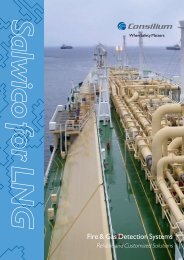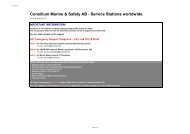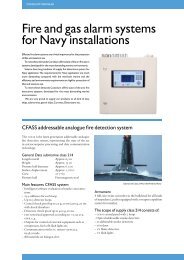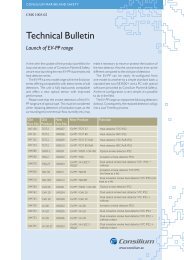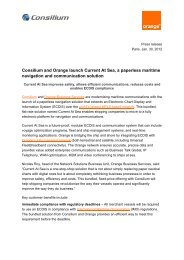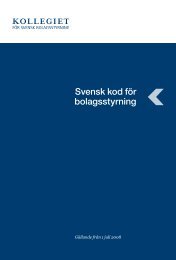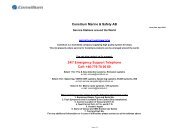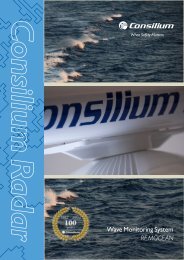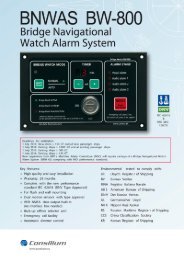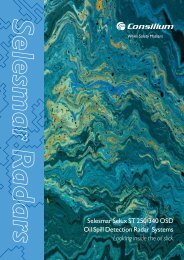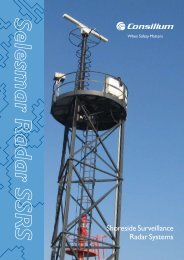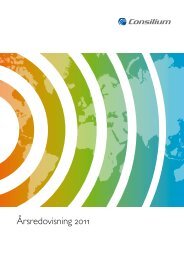Annual Report in English - Consilium
Annual Report in English - Consilium
Annual Report in English - Consilium
You also want an ePaper? Increase the reach of your titles
YUMPU automatically turns print PDFs into web optimized ePapers that Google loves.
CoRPoRAte GoveRnAnCe<br />
<strong>in</strong>ternational market organisation. More <strong>in</strong>formation about<br />
Group management can be found on page 61.<br />
operational control<br />
<strong>Consilium</strong>’s operations are organised <strong>in</strong>to a number of divisions<br />
<strong>in</strong> its two bus<strong>in</strong>ess areas, Mar<strong>in</strong>e & Safety and Fire safety &<br />
Automation, which are responsible for <strong>Consilium</strong>’s total offer<strong>in</strong>g<br />
<strong>in</strong> the form of products and systems. The operations are<br />
organised <strong>in</strong>to a clear functional structure, which allows the<br />
Company to leverage synergies and economies of scale <strong>in</strong> development,<br />
production, purchas<strong>in</strong>g, market<strong>in</strong>g and sales. The operations<br />
are led by the two bus<strong>in</strong>ess area managers. In parallel with<br />
<strong>Consilium</strong>’s product divisions, there is a global sales and service<br />
organisation led by the head of <strong>Consilium</strong>’s <strong>in</strong>ternational market<br />
organisation. All three managers report to the President & CEO.<br />
The Group’s bus<strong>in</strong>ess organisation is structured accord<strong>in</strong>g to<br />
the pr<strong>in</strong>ciple of decentralised responsibility and authority. Each<br />
bus<strong>in</strong>ess area has its own subsidiary board of which the Group<br />
President is chairman. Like the Parent Company, each subsidiary<br />
has a formal work plan for its board and written <strong>in</strong>structions for<br />
the manag<strong>in</strong>g directors. The subsidiaries also have a number of<br />
policies and <strong>in</strong>structions govern<strong>in</strong>g operations, <strong>in</strong>clud<strong>in</strong>g the bus<strong>in</strong>ess<br />
areas’ divisions. These areas <strong>in</strong>clude IT, environment, quality,<br />
equality, authorisation procedures, f<strong>in</strong>anc<strong>in</strong>g and currency hedg<strong>in</strong>g.<br />
The Group President has overall responsibility for day-to-day<br />
operations and their control, and the managers of the subsidiaries<br />
report on weekly order <strong>in</strong>take, <strong>in</strong>voic<strong>in</strong>g and order backlog for<br />
each profit centre. Monthly f<strong>in</strong>ancial statements are also prepared<br />
for each profit centre. These are analysed at different levels and<br />
consolidated at Group level.<br />
report<strong>in</strong>g<br />
Internal report<strong>in</strong>g takes place with<strong>in</strong> the same system used for<br />
preparation of the consolidated f<strong>in</strong>ancial statements and their<br />
quarterly presentation to the market. In addition to the <strong>in</strong>come<br />
statements and balance sheets, the monthly f<strong>in</strong>ancial reports<br />
conta<strong>in</strong> key f<strong>in</strong>ancial ratios and other relevant <strong>in</strong>formation.<br />
Analyses are made of <strong>in</strong>ventory levels and movements, trade<br />
receivables and customer credit periods.<br />
The fundamental pr<strong>in</strong>ciple of the Group’s report<strong>in</strong>g and followup<br />
systems is that they are characterised by transparency and<br />
decentralisation. The management of each subsidiary is strongly<br />
committed to develop<strong>in</strong>g and rationalis<strong>in</strong>g these processes.<br />
A key to success <strong>in</strong> this area is access to relevant and correct<br />
<strong>in</strong>formation, which is measured and followed up. Much effort has<br />
been devoted to the implementation and development of bus<strong>in</strong>ess<br />
systems for measur<strong>in</strong>g the profitability of <strong>in</strong>dividual transactions,<br />
customers, sectors and geographical markets. Individual costs<br />
are monitored and measured at critical stages <strong>in</strong> production,<br />
adm<strong>in</strong>istration and sales. These are then compared with previous<br />
results and targets. The <strong>in</strong>formation obta<strong>in</strong>ed is also used for<br />
<strong>in</strong>ternal benchmark<strong>in</strong>g, which encourages improvement and<br />
exemplifies good practice.<br />
remuneration of the Board and key Management<br />
Personnel<br />
The 2011 annual general meet<strong>in</strong>g adopted Board fees of SEK<br />
450,000, distributed as follows: Chairman of the Board SEK<br />
150,000, external Board members SEK 100,000 each.<br />
56<br />
The meet<strong>in</strong>g also adopted guidel<strong>in</strong>es relat<strong>in</strong>g to the compensation<br />
of key management personnel, which are essentially <strong>in</strong> l<strong>in</strong>e<br />
with market salaries and other terms of employment. Key management<br />
personnel’s compensation consists of the basic salary,<br />
<strong>in</strong>clud<strong>in</strong>g car allowance, and any bonuses earned. Pension is payable<br />
<strong>in</strong> accordance with the current ITP plan. Bonuses are l<strong>in</strong>ked<br />
to f<strong>in</strong>ancial targets and may not exceed three monthly salaries.<br />
The 2007 annual general meet<strong>in</strong>g authorised the Board of<br />
<strong>Consilium</strong> to establish an <strong>in</strong>centive scheme for key management<br />
personnel by issu<strong>in</strong>g up to 600,000 warrants entitl<strong>in</strong>g holders to<br />
subscribe for a total of 600,000 shares <strong>in</strong> <strong>Consilium</strong>. More <strong>in</strong>formation<br />
about the warrants can be found on page 23.<br />
Auditor<br />
The auditor’s task is to exam<strong>in</strong>e <strong>Consilium</strong>’s f<strong>in</strong>ancial statements<br />
and account<strong>in</strong>g records and the adm<strong>in</strong>istration of the Board<br />
and CEO. The chief auditor also submits an audit report to the<br />
annual general meet<strong>in</strong>g. Shareholders have the opportunity to put<br />
questions to the auditor at the meet<strong>in</strong>g.<br />
<strong>Consilium</strong>’s auditor is elected by the annual general meet<strong>in</strong>g.<br />
The 2010 annual general meet<strong>in</strong>g elected Sten Håkansson from<br />
Öhrl<strong>in</strong>gs PricewaterhouseCoopers AB as auditor for a period of<br />
three years. At the 2011 annual general meet<strong>in</strong>g, it was decided<br />
that auditors would be paid aga<strong>in</strong>st <strong>in</strong>voice <strong>in</strong> accordance with<br />
approved purchas<strong>in</strong>g pr<strong>in</strong>ciples.<br />
Fees paid to Öhrl<strong>in</strong>gs PricewaterhouseCoopers AB <strong>in</strong> 2011<br />
amounted to SEK 1.7 million (audit<strong>in</strong>g services SEK 1.7 million,<br />
other services SEK 0.0 million).<br />
<strong>Consilium</strong>’s stakeholders<br />
<strong>Consilium</strong> is dependent on a number of external parties.<br />
Cooperation and contacts with these parties may take the form<br />
of contractual and <strong>in</strong>formal relationships or partnerships. The<br />
Company’s stakeholders are parties who affect or can be affected<br />
by <strong>Consilium</strong>’s actions. The simplified stakeholder model on the<br />
follow<strong>in</strong>g page does not show fragmented stakeholders such as<br />
competitors with whom the Company does not have any clear<br />
relationship. Added to the model are phrases express<strong>in</strong>g values<br />
which are <strong>in</strong>herent <strong>in</strong> the relationships or which <strong>Consilium</strong> seeks<br />
to establish.<br />
Susta<strong>in</strong>able development<br />
<strong>Consilium</strong> is strongly committed to embrac<strong>in</strong>g the pr<strong>in</strong>ciples<br />
of susta<strong>in</strong>able development <strong>in</strong> its operations. <strong>Consilium</strong> sees<br />
susta<strong>in</strong>able development as “development that meets the needs<br />
of the present without compromis<strong>in</strong>g the ability of future<br />
generations to meet their own needs” (UN 1987). The Group’s<br />
susta<strong>in</strong>able development work will also focus on The Natural<br />
Step’s four susta<strong>in</strong>ability pr<strong>in</strong>ciples and the environmental quality<br />
objectives adopted by the Swedish parliament.<br />
It is <strong>Consilium</strong>’s goal that all product companies and production<br />
units will have an environmental management system accord<strong>in</strong>g<br />
to ISO 14000. It is important that the Company’s operations are<br />
planned, implemented, monitored and improved accord<strong>in</strong>g to<br />
this standard <strong>in</strong> order to reduce adverse environmental impacts.<br />
<strong>Consilium</strong> sees this work as a natural part of its commitment to<br />
the Company’s stakeholders. In addition, it is <strong>Consilium</strong>’s firm<br />
belief that a successful environmental programme also generates<br />
economic benefits, both <strong>in</strong> the short and long term.



